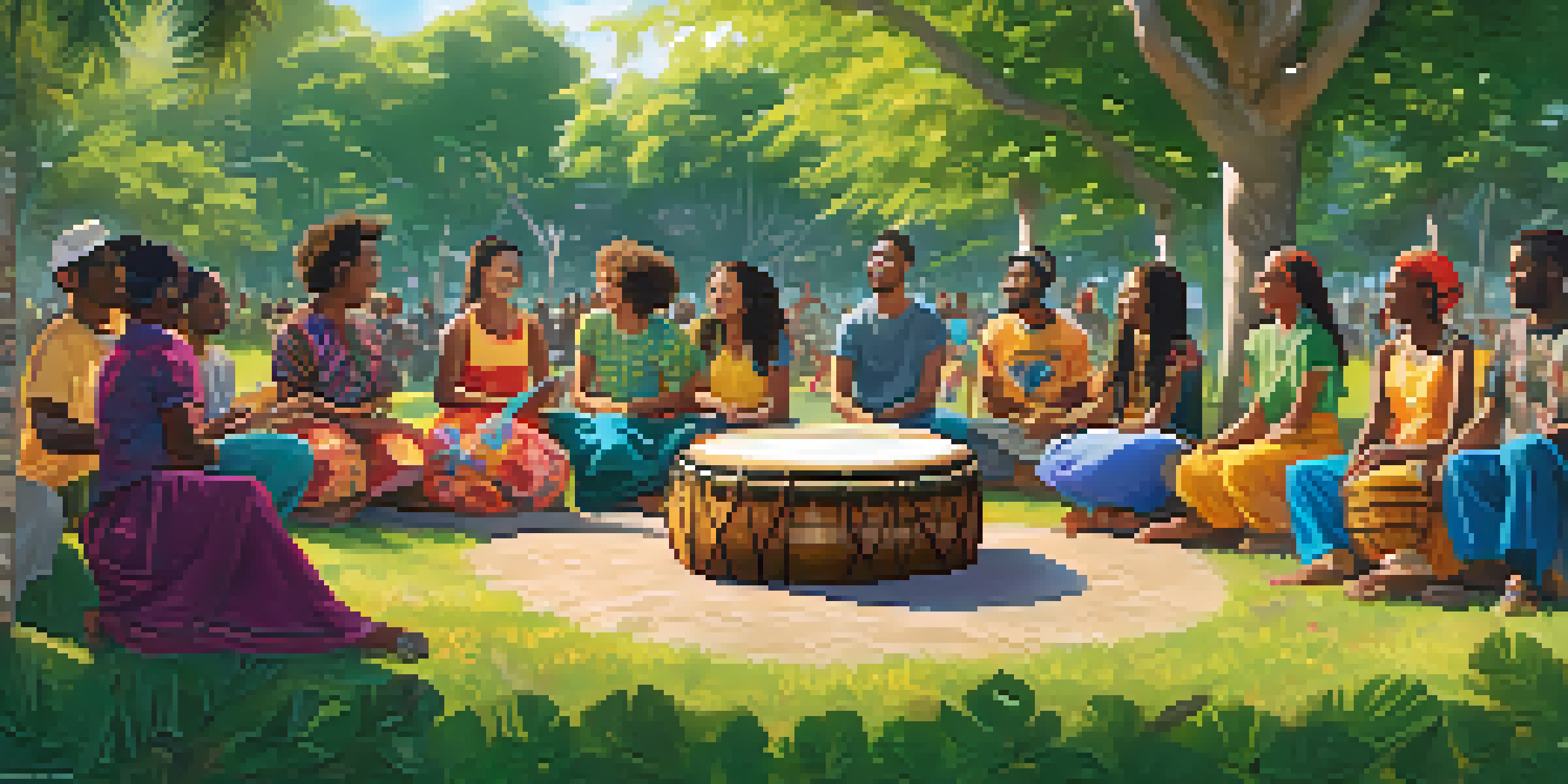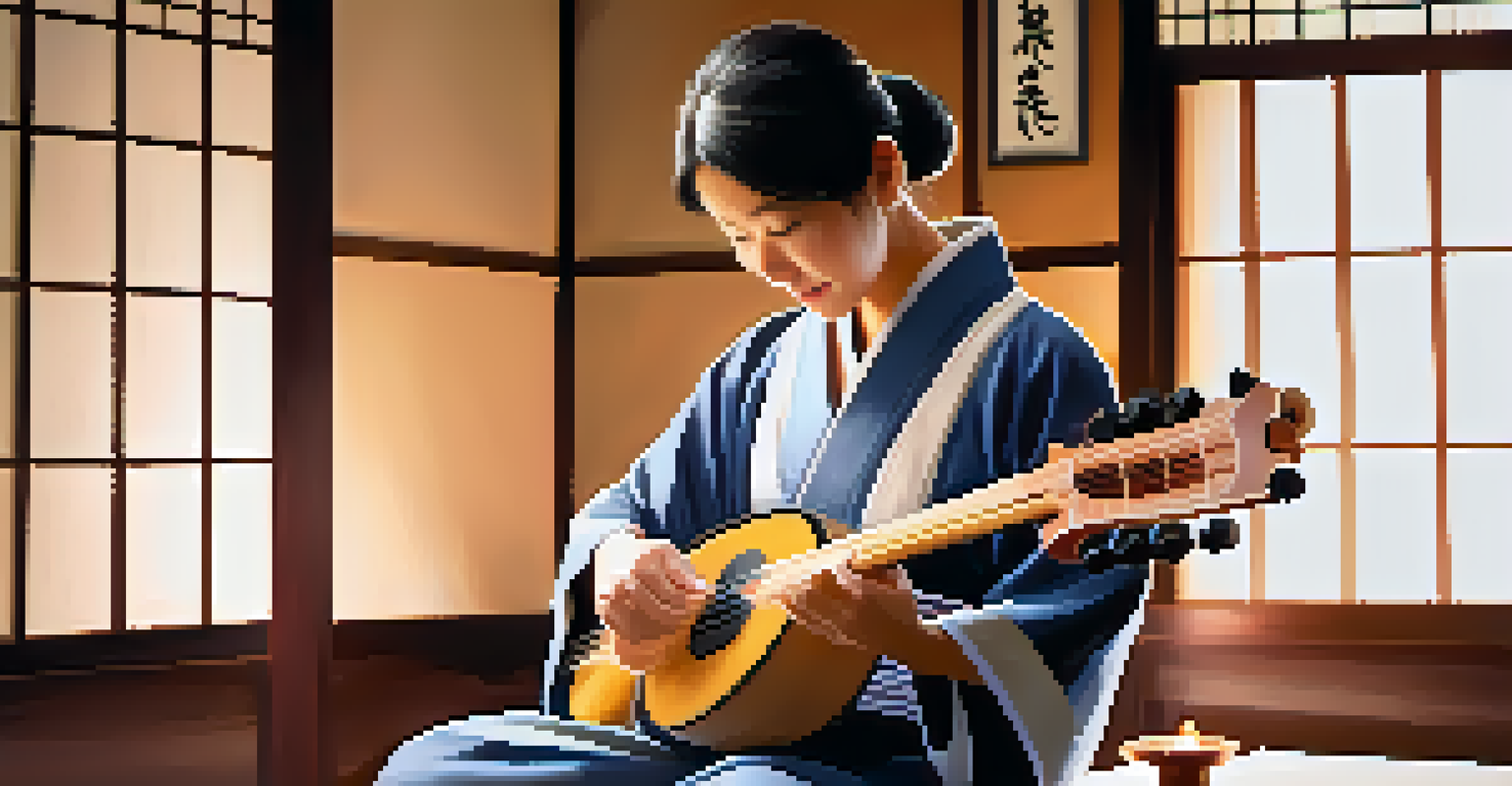Exploring Cross-Cultural Music Therapy Practices and Benefits

Understanding Music Therapy Across Cultures
Music therapy is a therapeutic approach that uses music to address emotional, cognitive, and social needs. This practice varies significantly across cultures, reflecting unique traditions and values. For instance, in some Indigenous cultures, music is woven into healing rituals, while in Western societies, it often focuses on structured therapeutic sessions.
Music can heal the soul, and it brings people together in ways that words cannot.
The essence of music therapy lies in its ability to connect people through shared musical experiences. Whether it's a drum circle in Africa or a classical music session in Europe, the underlying goal remains the same: to promote healing and well-being. This universality makes music therapy a fascinating field worth exploring.
As we dive into the various practices of music therapy, we'll discover how cultural context shapes these approaches. By appreciating the differences and similarities, we can better understand the profound impact of music on mental health and emotional healing.
Cultural Variations in Music Therapy Techniques
Different cultures employ unique techniques in music therapy that reflect their traditions. For example, in Japan, Koto therapy utilizes the traditional stringed instrument to evoke emotions and foster relaxation. Meanwhile, in Latin America, rhythms and dance are central, encouraging participants to express themselves freely.

These cultural variations highlight the importance of context in music therapy. A technique that works in one culture may not resonate in another, which is why therapists often adapt their methods to fit the cultural background of their clients. This flexibility ensures that music therapy is both effective and respectful of individual experiences.
Cultural Impact on Music Therapy
Music therapy practices vary widely across cultures, shaped by unique traditions and values.
By examining various techniques, we can see how music transcends language barriers and connects people on a deeper level. It encourages collaboration and understanding, making music therapy a powerful tool in a multicultural world.
The Role of Traditional Instruments in Healing
Traditional instruments play a crucial role in music therapy practices, often embodying the cultural heritage of a community. Instruments like the didgeridoo in Australia or the shamisen in Japan are not just tools; they are symbols of identity and connection. In therapy, they help clients engage with their cultural roots and foster a sense of belonging.
Where words fail, music speaks.
When clients interact with these instruments, they often experience a profound emotional release. For instance, a client playing the djembe drum may find it easier to express feelings of anger or joy, channeling their emotions through rhythm. This connection to traditional sounds can facilitate healing and personal growth.
Moreover, using traditional instruments in therapy can help bridge generational gaps, as younger individuals connect with the music of their ancestors. This practice fosters respect for cultural heritage while promoting mental and emotional well-being.
Music Therapy for Trauma Recovery
Music therapy has shown remarkable effectiveness in assisting individuals recovering from trauma. The soothing power of music can help clients process their experiences and emotions in a safe environment. Techniques such as songwriting or improvisation allow clients to express feelings that may be too difficult to articulate verbally.
For example, a survivor of conflict might use music to narrate their story, transforming pain into a creative outlet. This process not only aids in healing but also empowers clients to reclaim their narrative. Music becomes a vehicle for resilience, offering hope and solace.
Benefits of Community Initiatives
Community-based music therapy fosters social connections and enhances emotional well-being through collective musical experiences.
Furthermore, cross-cultural music therapy practices often incorporate traditional songs and chants that hold personal significance for clients. This connection to cultural heritage can enhance the therapeutic experience, making it more relatable and impactful.
Exploring Community-Based Music Therapy Initiatives
Community-based music therapy initiatives emphasize collaboration and collective healing. These programs often bring together diverse groups to create a shared musical experience, promoting social cohesion. For example, community drumming circles encourage participants to express themselves while building connections with others.
By fostering a sense of community, these initiatives can significantly enhance emotional well-being. Participants may find comfort in knowing they are not alone in their struggles, leading to improved mental health outcomes. This collective approach also celebrates cultural diversity, allowing individuals to share their musical traditions.
Moreover, community music therapy often includes educational elements, teaching participants about the therapeutic benefits of music. This knowledge empowers individuals to incorporate music into their daily lives, enhancing their overall quality of life.
Scientific Benefits of Cross-Cultural Music Therapy
The benefits of music therapy are not just anecdotal; numerous studies support its effectiveness in various cultural contexts. Research has shown that engaging with music can reduce anxiety, improve mood, and enhance cognitive function. For instance, studies involving diverse populations demonstrate that music therapy can lower stress levels and promote emotional regulation.
Furthermore, cross-cultural music therapy practices often lead to improved social skills and communication among participants. Engaging in group activities fosters teamwork and empathy, essential components for emotional well-being. Clients learn to listen to one another and collaborate, skills that extend beyond therapy sessions.
Challenges in Accessibility
Implementing cross-cultural music therapy faces challenges such as cultural sensitivity and limited access in underserved areas.
As the field of music therapy continues to grow, ongoing research will further illuminate its benefits across cultures. By understanding these scientific findings, we can advocate for the integration of music therapy in various settings, from hospitals to community centers.
Challenges in Implementing Cross-Cultural Music Therapy
While the benefits of cross-cultural music therapy are clear, implementing these practices can pose challenges. One significant hurdle is cultural sensitivity; therapists must be aware of the unique traditions and values of their clients. Misunderstanding or misrepresenting a cultural practice can lead to mistrust and hinder the therapeutic process.
Additionally, access to music therapy can be limited in some communities, especially in underserved areas. Many individuals may not have the opportunity to engage in such practices due to financial or logistical constraints. Addressing these barriers is crucial to make music therapy accessible to everyone, regardless of their background.

Despite these challenges, the growing interest in cross-cultural music therapy offers hope. By fostering dialogue and collaboration among practitioners, we can develop strategies to overcome obstacles and create inclusive environments for healing.
The Future of Cross-Cultural Music Therapy
The future of cross-cultural music therapy looks promising as the field continues to evolve. With an increasing appreciation for diverse musical traditions, therapists are better equipped to integrate various cultural elements into their practice. This evolution allows for more personalized and effective therapeutic experiences.
Moreover, advancements in technology are expanding access to music therapy. Online platforms and virtual sessions provide opportunities for individuals worldwide to engage with music therapy practices in their own cultural contexts. This accessibility can lead to a broader understanding and appreciation of global music therapy traditions.
As we look ahead, the emphasis on cultural competence in therapy will only grow. By valuing and respecting the musical heritage of clients, we can foster a more inclusive and effective therapeutic landscape that benefits everyone involved.